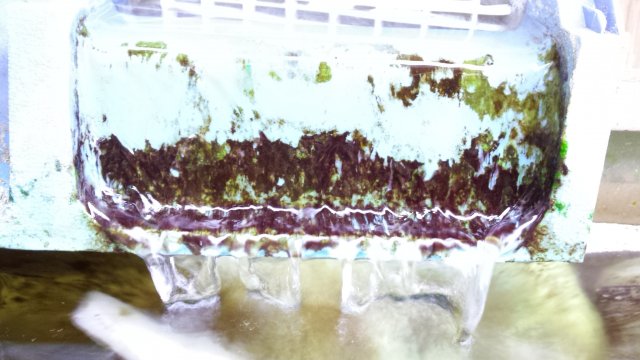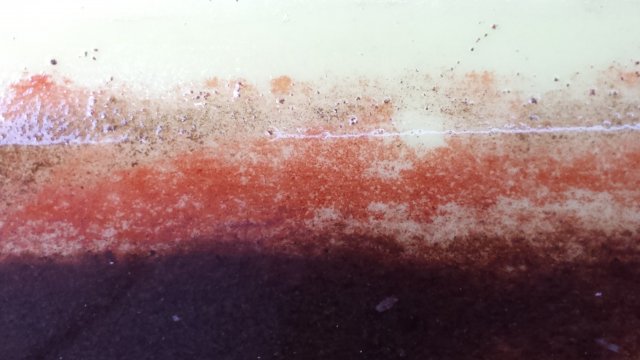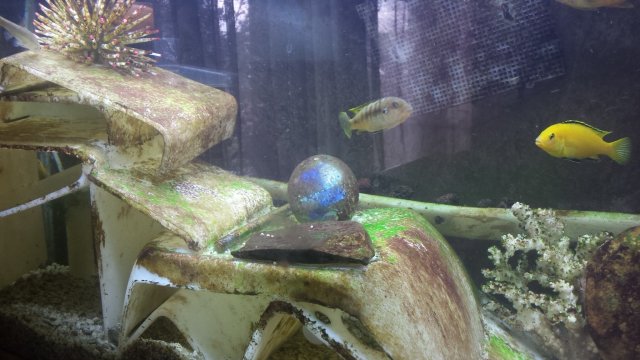Purple algae that mbuna will eat.
- Thread starter markstrimaran
- Start date
You are using an out of date browser. It may not display this or other websites correctly.
You should upgrade or use an alternative browser.
You should upgrade or use an alternative browser.
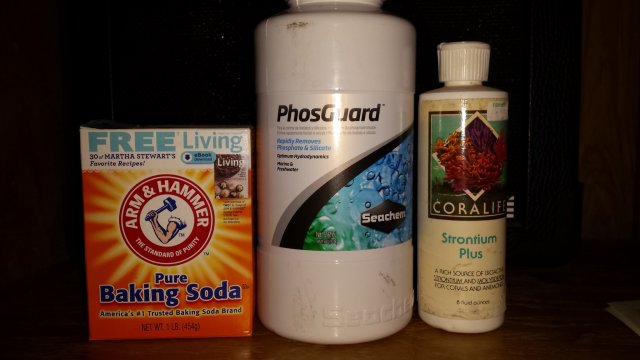
This 30 gallon is soon to be replaced with two 75 gallons. So I thought I would see if a saltwater coraline algae suppliment would would help it grow.
Earlier my nitrates went up too 20ppm, and my pH dropped to 7.2. I use a carbon dosing denitrator. It lowers the PH after a while.
I still had a small patch growing, we're the fish could not eat it. First I raised my PH to 7.8 waited a few days, nothing. Then I got the denitrator dialed in and lowered the Nitates down to 2 ppm. Had slight growth but not a lot like before.
Three days ago, I added calcium, and Strontium Plus, for corals. The purple algae has 10x growth since.
The Phosguard is for my silicate problem with my tap water. I have been using a 1/3 cup every couple of weeks.View attachment 1174827
This 30 gallon is soon to be replaced with two 75 gallons. So I thought I would see if a saltwater coraline algae suppliment would would help it grow.
Earlier my nitrates went up too 20ppm, and my pH dropped to 7.2. I use a carbon dosing denitrator. It lowers the PH after a while.
I still had a small patch growing, we're the fish could not eat it. First I raised my PH to 7.8 waited a few days, nothing. Then I got the denitrator dialed in and lowered the Nitates down to 2 ppm. Had slight growth but not a lot like before.
Three days ago, I added calcium, and Strontium Plus, for corals. The purple algae has 10x growth since.
Ok, this post has my vote for most interesting post of the year. Purple algae in an African tank. Never heard of it. Looking forward to updates and more photos.
The Krib ">Plants ">Algae[E-mail]Control of Red Algae in the Freshwater Aquariumby nfrank-at-nando.net (Neil Frank)
Date: Sat, 18 May 96
Because there has been a bit of discussion recently on 'beard' algae (both on this list and in the May issue of FAMA), I thought I would share an article that I have been working on. Much of this information has appeared in TAG or has been bantered about on the net, but I don't think it can all be found in one place.
Introduction
Among all the algae that can invade and gain a foothold in freshwater aquaria, red algae from the division Rhytophyta, can be the most frustrating to the hobbyist. This furry, thread-like flora attaches to various aquarium surfaces including the edges of plant leaves, filter tubes and even gravel. It may have many colors (purple, gray-green, black) and resembles beard hair or fur. In the aquarium literature, this nuisance is often called beard or brush algae. Baensch Aquarium Atlas' illustrate and talk about three forms. The long thread variety is called beard algae (once misprinted as bear algae), the shorter thread type is called brush algae; and a third type is described as having very short threads and forms dark roundish spots. While most algae from this family are actually found in marine or brackish water environments, there are a few species that inhabit freshwater (including the genera Audouinella). In nature, these epiphytic freshwater red algae are found in fast moving streams which provide a constant, but perhaps low concentration supply of nutrients including CO2. They also have the ability to attach tenaciously to all objects which makes them well suited to the moving water habitat. Unfortunately, they cannot be easily scraped or pulled from objects, thereby adding to the difficulty of their removal from the aquarium. In fact, when attempting to remove from plant leaves, the aquarist or even fishes may tear the leaf in the process. On the positive side, some hobbyists find this algae an interesting and welcome addition to their tanks. It may offer a special charm to driftwood or rocks, especially with the undulating movement created by the downwash of a filter outlet or powerhead.
The red algae is often the topic of discussion in aquarium literature. In the May 1996 issue ofFAMA, four separate articles mention it! In the lead article, Liisa Sarakontu and I talk about the Siamese Algae Eater (Crossocheilus siamensis, perhaps the only fish known to effectively eat and essentially eliminate this algae from the freshwater aquarium. Then Peter Lewis reports on this very same fact in his month column on fish trivia. Third, Simon Ellis presents "Its a Jungle in There" and mentions his unsuccessful battle with red algae. Finally, in the freshwater Q&A column, Simon appears again to ask Owen Jeffries: "How do I prevent a recurrence of the black bush [brush] algae." Owen, however, falls short of answering his question. Fortunately for Simon, there are many effective cures for the red algae plague. Here is the rest of the story.
Causes for Red Algae in the AquariumThe most likely reason for red algae is introduction of contaminated plants or a bag of fish from a store tank with red algae. This can come in as some small filaments floating in the water, as water born spores or perhaps in the digestive tract of fishes. Once deposited into a suitable aquarium environment, they may become established. It is evident from the picture of Simon's lush planted aquarium in the May FAMA that this was the case.
Unlike Jeffries, I do not believe that soil used under the substrate is a likely source of red algae. I have used soil in some of my planted tanks for many years and never saw red algae in these tanks, even before I found the Siamese Algae Eater. I am also not aware of this problem with many other aquatic gardeners who believe that the iron, manganese and other nutrients derivable from soil can be very helpful for a plant tank, provided that all other conditions are correct and the plant density is sufficient. Perhaps this route of entry is plausible if the soil is was taken from a river bank or if aquatic sediment is used. Nevertheless, deposited red algae will benefit from the extra nutrients which can also originate from soils.
Iron can be provided to the aquarium in several ways -- thru feeding and subsequent mineralization of detritus; with soil or laterite in the substrate, some from new water introduced with water changes, and with the addition of plant fertilizers. Sufficient iron is desirable, but too much is bad. While iron is needed for good growth of all plants, including algae, excess amounts will merely be extra food for algae and help it to thrive. Iron is often a limiting plant nutrient and it can be an indicator of the concentration of other needed trace nutrients.
Most iron in the aquarium (e.g. from decomposing organic matter, mineralized detritus or from added tap water) will be bound to oxygen or organic matter and will be less accessible to algae. Digested iron will be excreted as feces and deposit in the substrate. The same is true for any iron oxidizes, as contained in soils or laterite.
Limit the amount of added soluble, iron bearing aquarium plant fertilizer. Rooted plants can derive iron from the substrate in addition to getting it from the water. However, algae (and floating plants) can only get it from the water. So, one strategy is to reduce the amount of added iron. Many fertilizers contain a chelated form of iron which is designed to keep the iron in solution. The recommended dose is often designed to produce a concentration of approximately 0.10 ppm and may be based on daily or weekly additions. Unfortunately, label suggestions are based on some typical condition which may not be ideal for your situation. Depending on the nutrient uptake based on density of plants, their general health, growth rates as well as the existing reservoir of iron in the aquarium, the target concentration may be too high. Therefore, some trial and error may be needed to determine the correct dosage for your situation. I also note that the iron concentration is also an indicator of the amount of a variety of other trace element nutrients used by both higher plants and algae.Add iron directly to the substrate. A final way to reduce iron in the substrate is to not intentionally add any iron bearing fertilizers to the water. However, iron must still be made available to the plants. The latter reason is why good plant growth can occur in an established tank but not in some newly established
Another nutrient which may be related to the sustenance of red algae is inorganic carbon. This exists in the aquarium as dissolved CO2, bicarbonate or carbonates. The equilibrium of these carbon species depend on pH. Free CO2becomes available at pH less than 8.0 and predominates when pH is less than 6.5. In my experience, I have only seen red algae in low alkalinity, low pH conditions. Tanks with calcareous substrates will push the carbonate equilibrium from CO2 to HCO3- and red algae seem to diminish. Accordingly, I used to see beard and brush algae in my South American cichlid tanks, but never in the Tanganyikan tanks with their crushed coral substrate. It seems that red algae may be among those algae and water plants that can only utilize free CO2. On the other hand, some books suggest that adding CO2 will help eliminate red algae. Although this first appears to be a contradiction
increase the rate of plant growth. As mentioned earlier, with a large density of plants and bright light, the plants will suck up dissolved nutrients
Utilize algae eaters.The next major strategy for algae control involves algae eating. First and foremost is the Siamese algae Eater (Crossocheilus siamensis), perhaps the only known fish to eat red algae.
Date: Sat, 18 May 96
Because there has been a bit of discussion recently on 'beard' algae (both on this list and in the May issue of FAMA), I thought I would share an article that I have been working on. Much of this information has appeared in TAG or has been bantered about on the net, but I don't think it can all be found in one place.
Introduction
Among all the algae that can invade and gain a foothold in freshwater aquaria, red algae from the division Rhytophyta, can be the most frustrating to the hobbyist. This furry, thread-like flora attaches to various aquarium surfaces including the edges of plant leaves, filter tubes and even gravel. It may have many colors (purple, gray-green, black) and resembles beard hair or fur. In the aquarium literature, this nuisance is often called beard or brush algae. Baensch Aquarium Atlas' illustrate and talk about three forms. The long thread variety is called beard algae (once misprinted as bear algae), the shorter thread type is called brush algae; and a third type is described as having very short threads and forms dark roundish spots. While most algae from this family are actually found in marine or brackish water environments, there are a few species that inhabit freshwater (including the genera Audouinella). In nature, these epiphytic freshwater red algae are found in fast moving streams which provide a constant, but perhaps low concentration supply of nutrients including CO2. They also have the ability to attach tenaciously to all objects which makes them well suited to the moving water habitat. Unfortunately, they cannot be easily scraped or pulled from objects, thereby adding to the difficulty of their removal from the aquarium. In fact, when attempting to remove from plant leaves, the aquarist or even fishes may tear the leaf in the process. On the positive side, some hobbyists find this algae an interesting and welcome addition to their tanks. It may offer a special charm to driftwood or rocks, especially with the undulating movement created by the downwash of a filter outlet or powerhead.
The red algae is often the topic of discussion in aquarium literature. In the May 1996 issue ofFAMA, four separate articles mention it! In the lead article, Liisa Sarakontu and I talk about the Siamese Algae Eater (Crossocheilus siamensis, perhaps the only fish known to effectively eat and essentially eliminate this algae from the freshwater aquarium. Then Peter Lewis reports on this very same fact in his month column on fish trivia. Third, Simon Ellis presents "Its a Jungle in There" and mentions his unsuccessful battle with red algae. Finally, in the freshwater Q&A column, Simon appears again to ask Owen Jeffries: "How do I prevent a recurrence of the black bush [brush] algae." Owen, however, falls short of answering his question. Fortunately for Simon, there are many effective cures for the red algae plague. Here is the rest of the story.
Causes for Red Algae in the AquariumThe most likely reason for red algae is introduction of contaminated plants or a bag of fish from a store tank with red algae. This can come in as some small filaments floating in the water, as water born spores or perhaps in the digestive tract of fishes. Once deposited into a suitable aquarium environment, they may become established. It is evident from the picture of Simon's lush planted aquarium in the May FAMA that this was the case.
Unlike Jeffries, I do not believe that soil used under the substrate is a likely source of red algae. I have used soil in some of my planted tanks for many years and never saw red algae in these tanks, even before I found the Siamese Algae Eater. I am also not aware of this problem with many other aquatic gardeners who believe that the iron, manganese and other nutrients derivable from soil can be very helpful for a plant tank, provided that all other conditions are correct and the plant density is sufficient. Perhaps this route of entry is plausible if the soil is was taken from a river bank or if aquatic sediment is used. Nevertheless, deposited red algae will benefit from the extra nutrients which can also originate from soils.
Iron can be provided to the aquarium in several ways -- thru feeding and subsequent mineralization of detritus; with soil or laterite in the substrate, some from new water introduced with water changes, and with the addition of plant fertilizers. Sufficient iron is desirable, but too much is bad. While iron is needed for good growth of all plants, including algae, excess amounts will merely be extra food for algae and help it to thrive. Iron is often a limiting plant nutrient and it can be an indicator of the concentration of other needed trace nutrients.
Most iron in the aquarium (e.g. from decomposing organic matter, mineralized detritus or from added tap water) will be bound to oxygen or organic matter and will be less accessible to algae. Digested iron will be excreted as feces and deposit in the substrate. The same is true for any iron oxidizes, as contained in soils or laterite.
Limit the amount of added soluble, iron bearing aquarium plant fertilizer. Rooted plants can derive iron from the substrate in addition to getting it from the water. However, algae (and floating plants) can only get it from the water. So, one strategy is to reduce the amount of added iron. Many fertilizers contain a chelated form of iron which is designed to keep the iron in solution. The recommended dose is often designed to produce a concentration of approximately 0.10 ppm and may be based on daily or weekly additions. Unfortunately, label suggestions are based on some typical condition which may not be ideal for your situation. Depending on the nutrient uptake based on density of plants, their general health, growth rates as well as the existing reservoir of iron in the aquarium, the target concentration may be too high. Therefore, some trial and error may be needed to determine the correct dosage for your situation. I also note that the iron concentration is also an indicator of the amount of a variety of other trace element nutrients used by both higher plants and algae.Add iron directly to the substrate. A final way to reduce iron in the substrate is to not intentionally add any iron bearing fertilizers to the water. However, iron must still be made available to the plants. The latter reason is why good plant growth can occur in an established tank but not in some newly established
Another nutrient which may be related to the sustenance of red algae is inorganic carbon. This exists in the aquarium as dissolved CO2, bicarbonate or carbonates. The equilibrium of these carbon species depend on pH. Free CO2becomes available at pH less than 8.0 and predominates when pH is less than 6.5. In my experience, I have only seen red algae in low alkalinity, low pH conditions. Tanks with calcareous substrates will push the carbonate equilibrium from CO2 to HCO3- and red algae seem to diminish. Accordingly, I used to see beard and brush algae in my South American cichlid tanks, but never in the Tanganyikan tanks with their crushed coral substrate. It seems that red algae may be among those algae and water plants that can only utilize free CO2. On the other hand, some books suggest that adding CO2 will help eliminate red algae. Although this first appears to be a contradiction
increase the rate of plant growth. As mentioned earlier, with a large density of plants and bright light, the plants will suck up dissolved nutrients
Utilize algae eaters.The next major strategy for algae control involves algae eating. First and foremost is the Siamese algae Eater (Crossocheilus siamensis), perhaps the only known fish to eat red algae.
View attachment 1174829
This was taken today. This purple algae has been growing here for over a month. It's not slimey more leathery feeling.
On the bright side of my HOB filter.
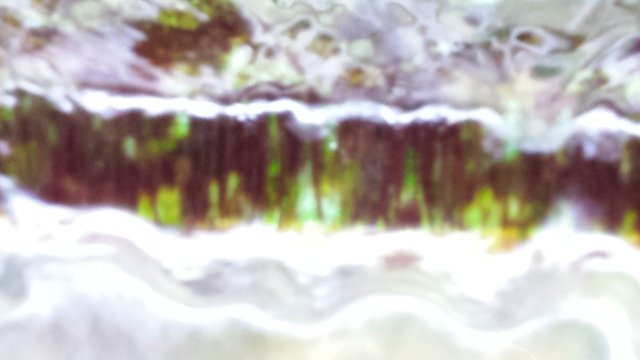
After adding suppliments it is now a 1/4" long.


